airbag MITSUBISHI iMiEV 2016 1.G Owners Manual
[x] Cancel search | Manufacturer: MITSUBISHI, Model Year: 2016, Model line: iMiEV, Model: MITSUBISHI iMiEV 2016 1.GPages: 296, PDF Size: 7.79 MB
Page 2 of 296
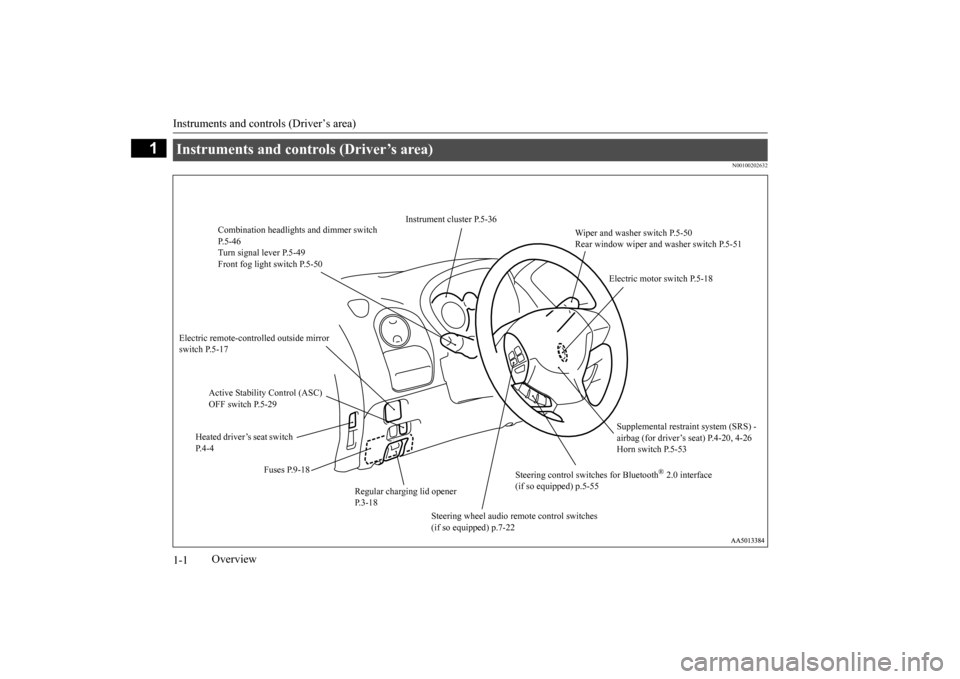
Instruments and controls (Driver’s area) 1-1
1
Overview
N00100202632
Instruments and controls (Driver’s area)
Wiper and washer switch P.5-50 Rear window wiper and washer switch P.5-51
Instrument cluster P.5-36
Combination headlight
s and dimmer switch
P.5-46 Turn signal lever P.5-49Front fog light switch P.5-50
Electric motor switch P.5-18
Electric remote-controlled outside mirror switch P.5-17
Active Stability Control (ASC) OFF switch P.5-29
Supplemental restraint system (SRS) - airbag (for driver’s seat) P.4-20, 4-26Horn switch P.5-53
Heated driver’s seat switch P. 4 - 4
Fuses P.9-18
Regular charging lid opener P.3-18
Steering control switches for Bluetooth
® 2.0 interface
(if so equipped) p.5-55
Steering wheel audio remote control switches (if so equipped) p.7-22
BK0220401US.book 1 ページ 2015年6月3日 水曜日 午前7時42分
Page 3 of 296
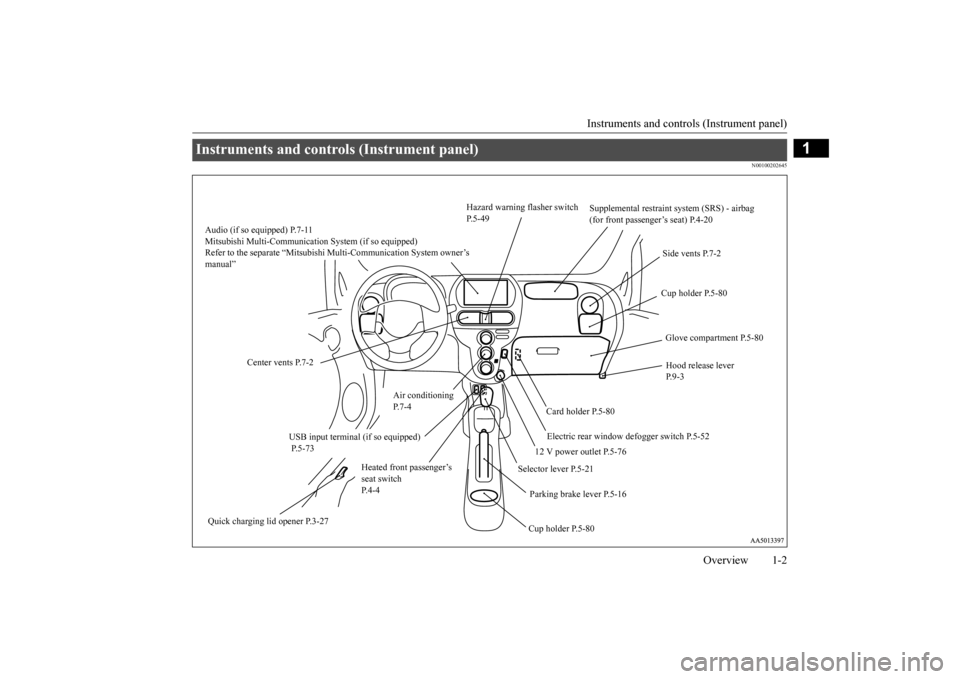
Instruments and controls (Instrument panel)
Overview 1-2
1
N00100202645
Instruments and controls (Instrument panel)
Hazard warning flasher switch P.5-49
Supplemental restraint system (SRS) - airbag (for front passenger’s seat) P.4-20
Side vents P.7-2 Cup holder P.5-80 Glove compartment P.5-80
Center vents P.7-2
Hood release lever P. 9 - 3
Air conditioning P. 7 - 4
Card holder P.5-80 Electric rear window defogger switch P.5-52
12 V power outlet P.5-76
Selector lever P.5-21
Heated front passenger’s seat switchP. 4 - 4
Parking brake lever P.5-16
Quick charging lid opener P.3-27
Cup holder P.5-80
USB input terminal (if so equipped) P.5-73
Audio (if so equipped) P.7-11 Mitsubishi Multi-Communication System (if so equipped) Refer to the separate “Mitsubishi
Multi-Communication System owner’s
manual”
BK0220401US.book 2 ページ 2015年6月3日 水曜日 午前7時42分
Page 4 of 296
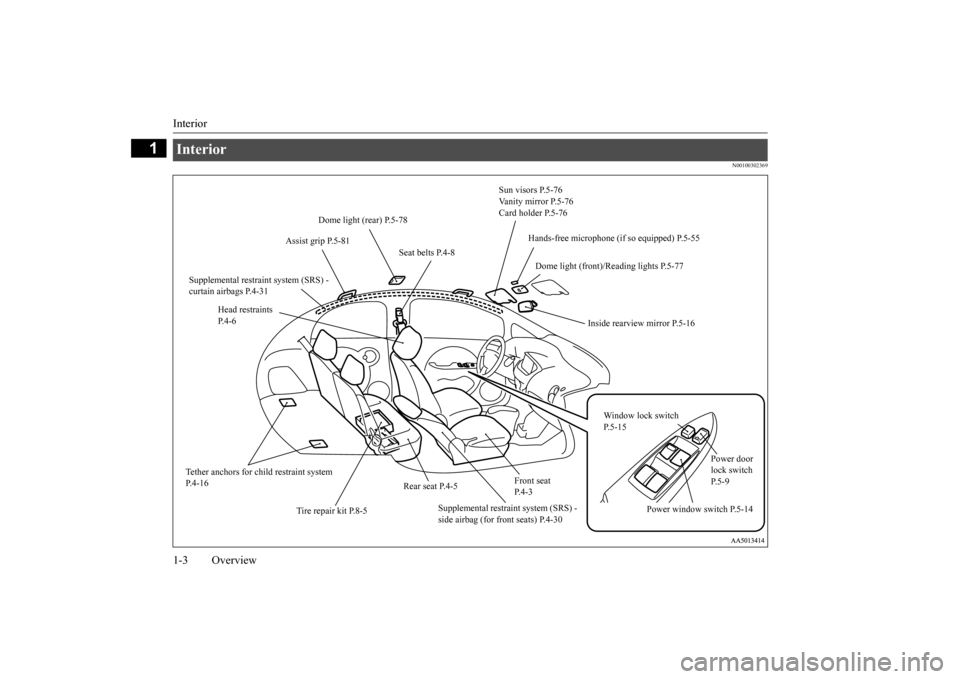
Interior 1-3 Overview
1
N00100302369
Interior
Sun visors P.5-76 Vanity mirror P.5-76 Card holder P.5-76
Dome light (rear) P.5-78
Assist grip P.5-81
Seat belts P.4-8
Supplemental restraint system (SRS) - curtain airbags P.4-31
Dome light (front)/Reading lights P.5-77
Head restraints P. 4 - 6
Inside rearview mirror P.5-16
Window lock switch P.5-15
Power door lock switch P. 5 - 9
Tether anchors for ch
ild restraint system
P.4-16
Front seat P. 4 - 3
Rear seat P.4-5
Power window switch P.5-14
Supplemental restraint system (SRS) - side airbag (for front seats) P.4-30
Tire repair kit P.8-5
Hands-free microphone (if so equipped) P.5-55
BK0220401US.book 3 ページ 2015年6月3日 水曜日 午前7時42分
Page 22 of 296
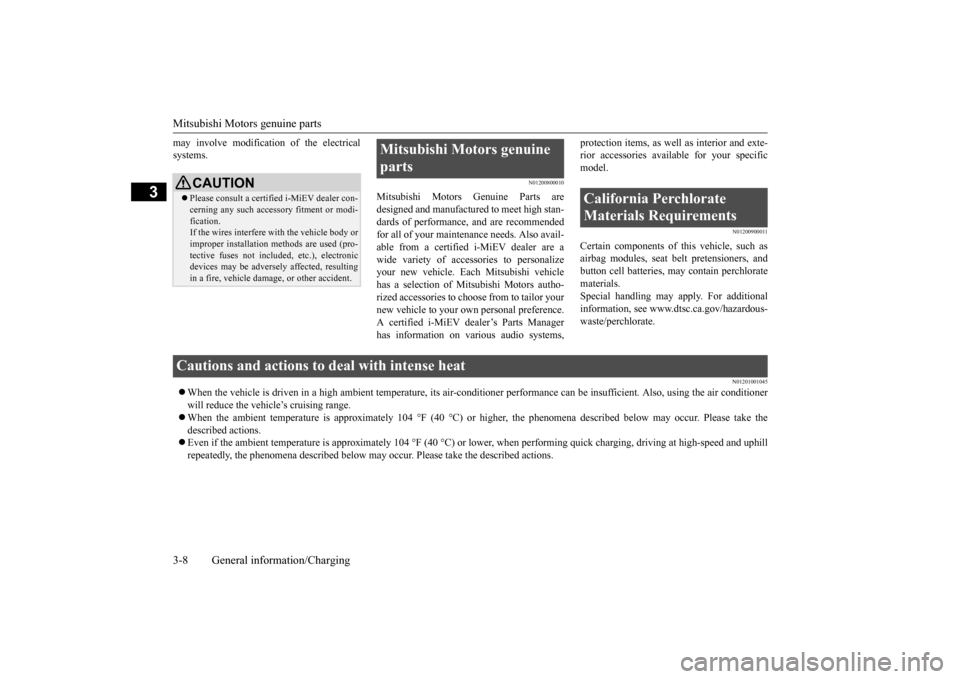
Mitsubishi Motors genuine parts 3-8 General information/Charging
3
may involve m
odification of the electrical
systems.
N01200800010
Mitsubishi Motors Genuine Parts are designed and manufacture
d to meet high stan-
dards of performance, and are recommendedfor all of your maintenance needs. Also avail- able from a certified i-MiEV dealer are a wide variety of acce
ssories to personalize
your new vehicle. Ea
ch Mitsubishi vehicle
has a selection of Mi
tsubishi Motors autho-
rized accessories to c
hoose from to tailor your
new vehicle to your own personal preference. A certified i-MiEV de
aler’s Parts Manager
has information on va
rious audio systems,
protection items, as well
as interior and exte-
rior accessories available for your specificmodel.
N01200900011
Certain components of th
is vehicle, such as
airbag modules, seat belt pretensioners, and button cell batteries,
may contain perchlorate
materials. Special handling may a
pply. For additional
information, see www
.dtsc.ca.gov/hazardous-
waste/perchlorate.
N01201001045
When the vehicle is driven in a high ambi
ent temperature, its air-conditioner performan
ce can be insufficient. Also, using the
air conditioner
will reduce the vehicle’s cruising range. When the ambient temperature is approximately 104 °F (40 °C) or
higher, the phenomena described be
low may occur. Please take th
e
described actions. Even if the ambient temperature is approx
imately 104 °F (40 °C) or lower, when perfo
rming quick charging,
driving at high-speed
and uphill
repeatedly, the phenomena described below may
occur. Please take the described actions.
CAUTIONPlease consult a certif
ied i-MiEV dealer con-
cerning any such accessory fitment or modi- fication. If the wires interfere
with the vehicle body or
improper installation me
thods are used (pro-
tective fuses not included, etc.), electronic devices may be adversel
y affected, resulting
in a fire, vehicle dama
ge, or other accident.
Mitsubishi Motors genuine parts
California Perchlorate Materials Requirements
Cautions and actions to deal with intense heat BK0220401US.book 8 ページ 2015年6月3日 水曜日 午前7時42分
Page 73 of 296
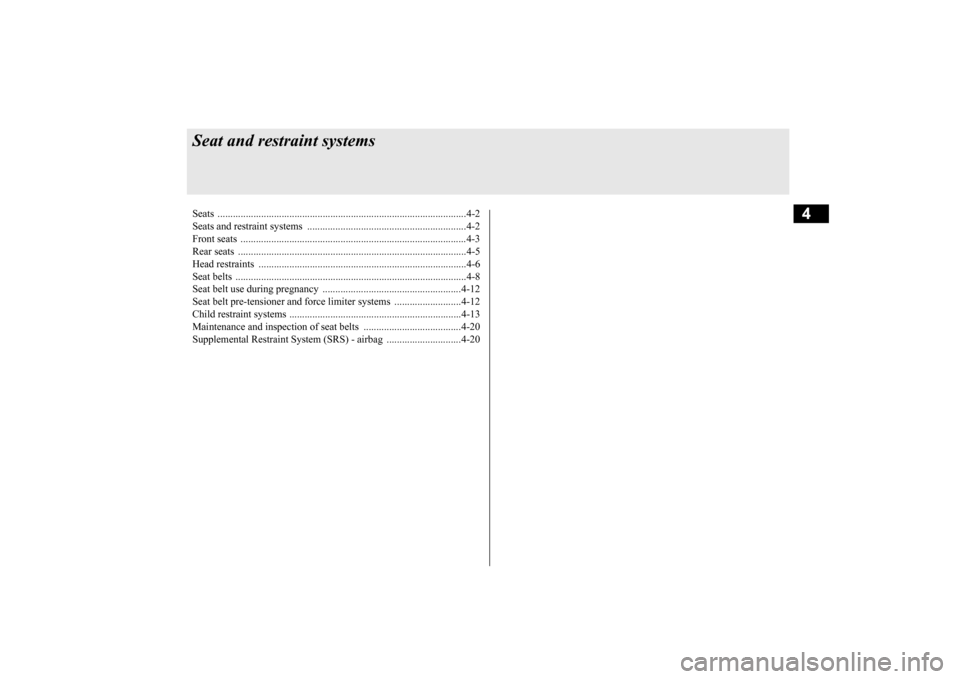
4
Seat and restraint systemsSeats .................................................................................................4-2 Seats and restraint systems ..............................................................4-2 Front seats ........................................................................................4-3Rear seats .........................................................................................4-5 Head restraints .................................................................................4-6 Seat belts ..........................................................................................4-8Seat belt use during pregnancy ......................................................4-12 Seat belt pre-tensioner and force limiter systems ..........................4-12 Child restraint systems ...................................................................4-13Maintenance and inspection of seat belts ......................................4-20 Supplemental Restraint Syst
em (SRS) - airbag ......
.........
.........
.....4-20
BK0220401US.book 1 ページ 2015年6月3日 水曜日 午前7時42分
Page 74 of 296
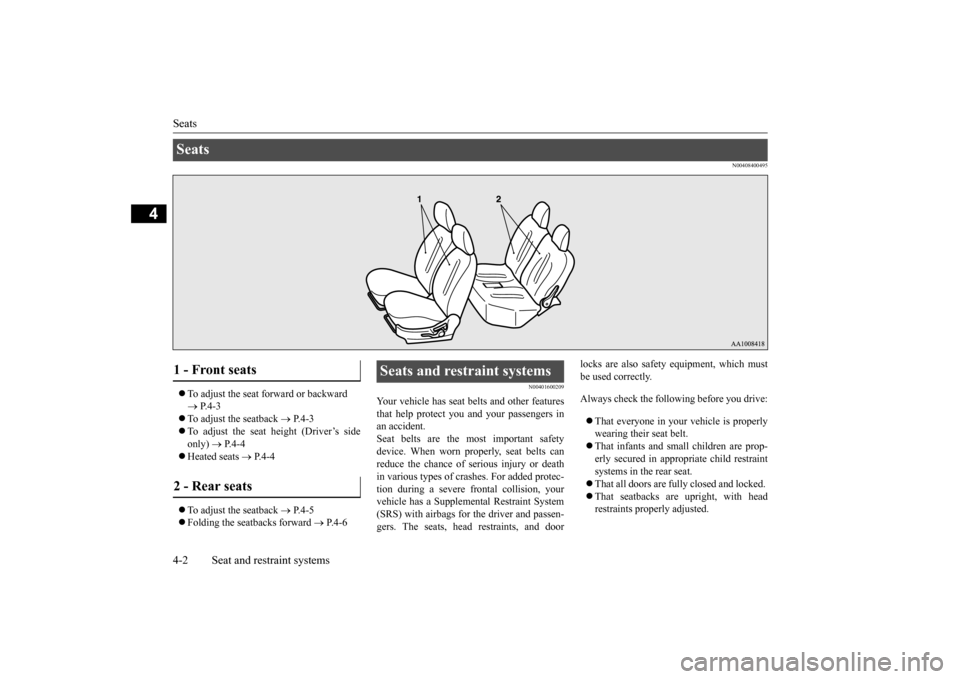
Seats 4-2 Seat and restraint systems
4
N00408400495
To adjust the seat forward or backward P.4-3
To adjust the seatback
P.4-3
To adjust the seat
height (Driver’s side
only)
P.4-4
Heated seats
P. 4 - 4
To adjust the seatback
P.4-5
Folding the seatbacks forward
P.4-6
N00401600209
Your vehicle has seat belts and other features that help protect you and your passengers in an accident.Seat belts are the most important safety device. When worn properly, seat belts can reduce the chance of serious injury or deathin various types of cras
hes. For added protec-
tion during a severe fr
ontal collision, your
vehicle has a Supplemen
tal Restraint System
(SRS) with airbags for the driver and passen- gers. The seats, head restraints, and door
locks are also safety equipment, which must be used correctly. Always check the following before you drive: That everyone in your vehicle is properly wearing their seat belt. That infants and small children are prop- erly secured in appropriate child restraintsystems in the rear seat. That all doors are fully closed and locked. That seatbacks are upright, with head restraints properly adjusted.
Seats 1 - Front seats 2 - Rear seats
Seats and restraint systems
BK0220401US.book 2 ページ 2015年6月3日 水曜日 午前7時42分
Page 75 of 296
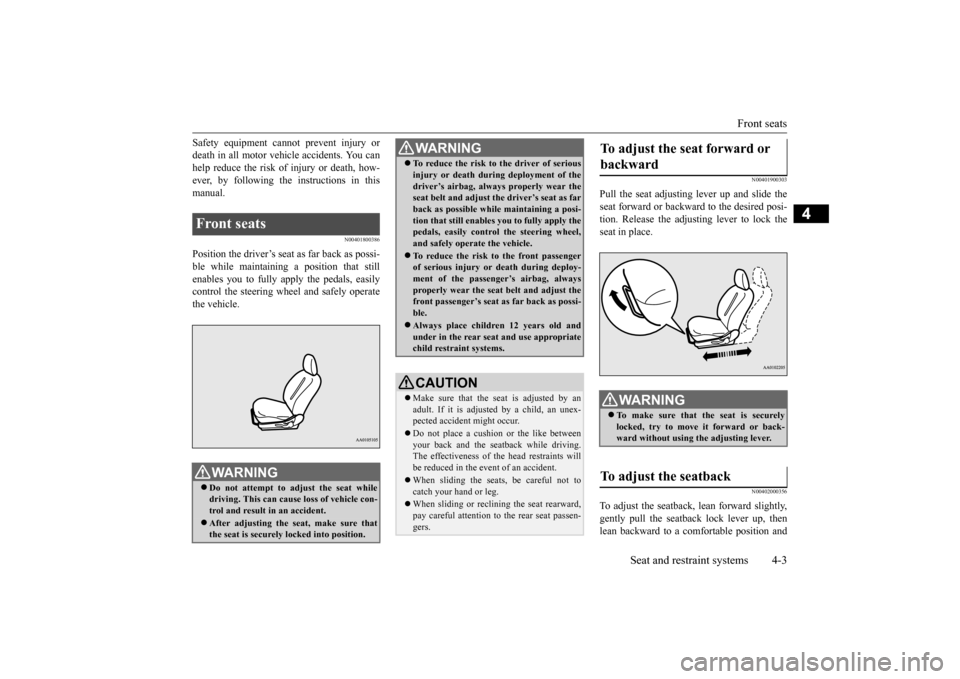
Front seats
Seat and restraint systems 4-3
4
Safety equipment cannot prevent injury or death in all motor vehi
cle accidents. You can
help reduce the risk of injury or death, how- ever, by following the instructions in this manual.
N00401800386
Position the driver’s seat
as far back as possi-
ble while maintaining a position that still enables you to fully apply the pedals, easily control the steering wh
eel and safely operate
the vehicle.
N00401900303
Pull the seat adjusting lever up and slide theseat forward or backwa
rd to the desired posi-
tion. Release the adjusting lever to lock the seat in place.
N00402000356
To adjust the seatback,
lean forward slightly,
gently pull the seatback lock lever up, then lean backward to a comfortable position and
Front seats
WA R N I N G Do not attempt to adjust the seat while driving. This can cause loss of vehicle con- trol and result
in an accident.
After adjusting the se
at, make sure that
the seat is securely locked into position.
To reduce the risk to the driver of serious injury or death during deployment of thedriver’s airbag, always
properly wear the
seat belt and adjust th
e driver’s seat as far
back as possible while maintaining a posi- tion that still enables
you to fully apply the
pedals, easily control the steering wheel, and safely operate the vehicle. To reduce the risk to the front passenger of serious injury or
death during deploy-
ment of the passeng
er’s airbag, always
properly wear the seat
belt and adjust the
front passenger’s seat as far back as possi- ble. Always place childr
en 12 years old and
under in the rear seat
and use appropriate
child restraint systems.CAUTION Make sure that the seat is adjusted by an adult. If it is adjusted by a child, an unex- pected accident might occur. Do not place a cushion
or the like between
your back and the seatback while driving. The effectiveness of the head restraints willbe reduced in the event of an accident. When sliding the seats, be careful not to catch your hand or leg. When sliding or reclining the seat rearward, pay careful attention to
the rear seat passen-
gers.WA R N I N G
To adjust the seat forward or backward
WA R N I N G To make sure that the seat is securely locked, try to move
it forward or back-
ward without using th
e adjusting lever.
To adjust the seatback
BK0220401US.book 3 ページ 2015年6月3日 水曜日 午前7時42分
Page 80 of 296
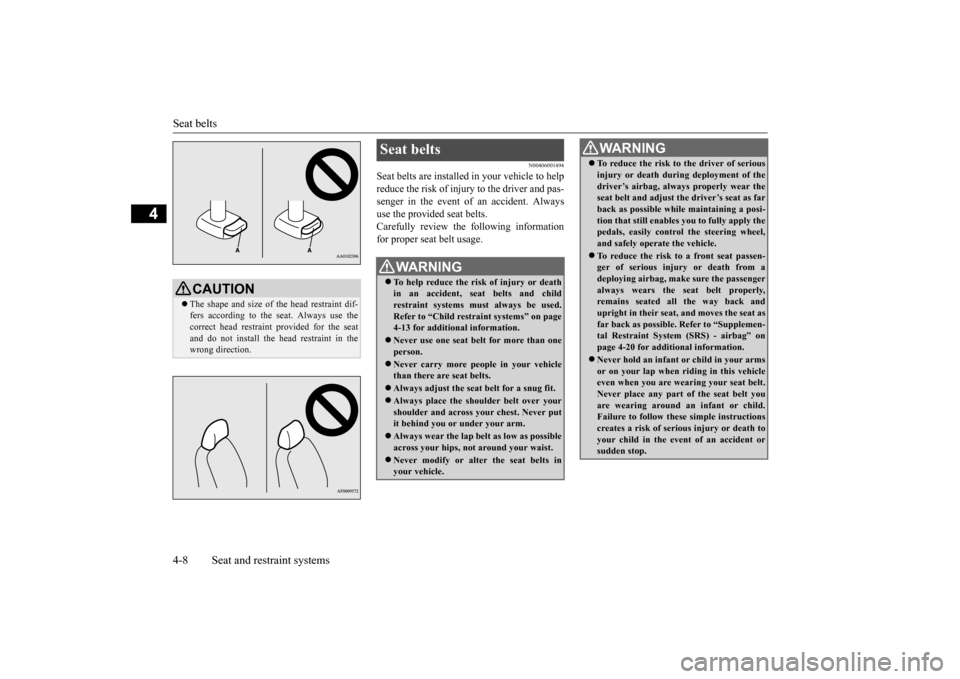
Seat belts 4-8 Seat and restraint systems
4
N00406001494
Seat belts are installed
in your vehicle to help
reduce the risk of injury to the driver and pas- senger in the event of an accident. Alwaysuse the provided seat belts. Carefully review the following information for proper seat belt usage.
CAUTION The shape and size of the head restraint dif- fers according to the seat. Always use thecorrect head restraint provided for the seat and do not install the he
ad restraint in the
wrong direction.
Seat belts
WA R N I N G To help reduce the risk of injury or death in an accident, se
at belts and child
restraint systems must always be used. Refer to “Child restraint systems” on page4-13 for additional information. Never use one seat belt for more than one person. Never carry more peop
le in your vehicle
than there are seat belts. Always adjust the seat belt for a snug fit.Always place the shou
lder belt over your
shoulder and across
your chest. Never put
it behind you or
under your arm.
Always wear the lap belt as low as possible across your hips, not around your waist. Never modify or alter the seat belts in your vehicle.
To reduce the risk to the driver of serious injury or death duri
ng deployment of the
driver’s airbag, always
properly wear the
seat belt and adjust th
e driver’s seat as far
back as possible while maintaining a posi- tion that still enables
you to fully apply the
pedals, easily control the steering wheel, and safely operate the vehicle. To reduce the risk to a front seat passen- ger of serious injury or death from a deploying airbag, make sure the passengeralways wears the seat belt properly, remains seated all the way back and upright in their seat,
and moves the seat as
far back as possible. Refer to “Supplemen- tal Restraint System (SRS) - airbag” on page 4-20 for additional information. Never hold an infant
or child in your arms
or on your lap when ri
ding in this vehicle
even when you are we
aring your seat belt.
Never place any part of the seat belt you are wearing around an infant or child.Failure to follow these simple instructions creates a risk of serious injury or death to your child in the event of an accident orsudden stop.WA R N I N G
BK0220401US.book 8 ページ 2015年6月3日 水曜日 午前7時42分
Page 81 of 296
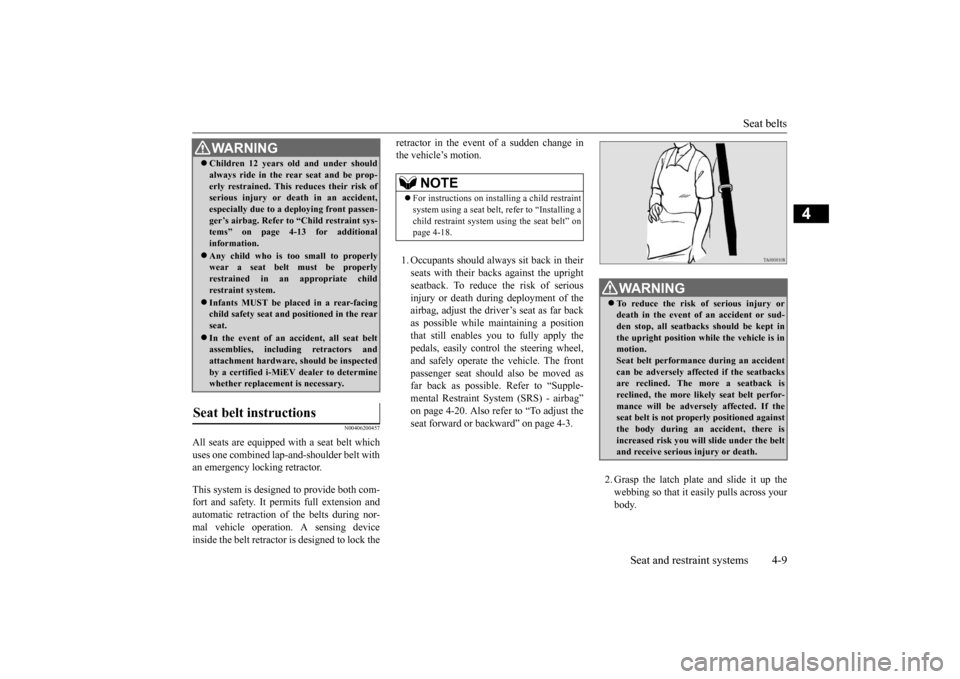
Seat belts
Seat and restraint systems 4-9
4
N00406200457
All seats are equipped with a seat belt which uses one combined lap-and-shoulder belt with an emergency locking retractor. This system is designed to provide both com- fort and safety. It perm
its full extension and
automatic retraction of the belts during nor- mal vehicle operation.
A sensing device
inside the belt retractor is designed to lock the
retractor in the event of a sudden change in the vehicle’s motion. 1. Occupants should always
sit back in their
seats with their backs against the upright seatback. To reduce
the risk of serious
injury or death during deployment of theairbag, adjust the driver’s seat as far back as possible while maintaining a position that still enables you to fully apply thepedals, easily control the steering wheel, and safely operate the vehicle. The front passenger seat should also be moved asfar back as possible. Refer to “Supple- mental Restraint System (SRS) - airbag” on page 4-20. Also refer to “To adjust theseat forward or backward” on page 4-3.
2. Grasp the latch plat
e and slide it up the
webbing so that it easily pulls across yourbody.
Children 12 years ol
d and under should
always ride in the re
ar seat and be prop-
erly restrained. This reduces their risk ofserious injury or de
ath in an accident,
especially due to a deploying front passen- ger’s airbag. Refer to
“Child restraint sys-
tems” on page 4-13 for additional information. Any child who is t
oo small to properly
wear a seat belt must be properly restrained in an appropriate childrestraint system. Infants MUST be placed in a rear-facing child safety seat and
positioned in the rear
seat. In the event of an ac
cident, all seat belt
assemblies, including retractors and attachment hardware, should be inspectedby a certified i-MiEV dealer to determine whether replacement is necessary.
Seat belt instructions
WA R N I N G
NOTE
For instructions on installing a child restraint system using a seat belt
, refer to “Installing a
child restraint system using the seat belt” on page 4-18.
WA R N I N G To reduce the risk of serious injury or death in the event of
an accident or sud-
den stop, all seatbacks should be kept in the upright position while the vehicle is inmotion. Seat belt performance during an accident can be adversely affect
ed if the seatbacks
are reclined. The more a seatback is reclined, the more likely seat belt perfor- mance will be advers
ely affected. If the
seat belt is not prop
erly positioned against
the body during an accident, there is increased risk you will slide under the beltand receive serious
injury or death.
BK0220401US.book 9 ページ 2015年6月3日 水曜日 午前7時42分
Page 84 of 296
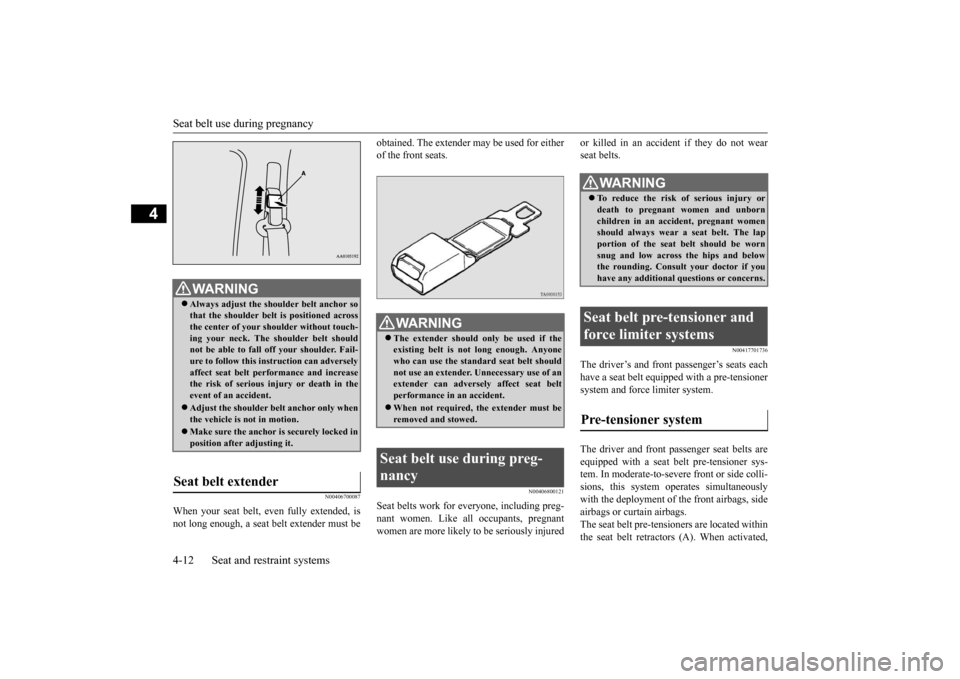
Seat belt use during pregnancy 4-12 Seat and restraint systems
4
N00406700087
When your seat belt, even fully extended, is not long enough, a seat belt extender must be
obtained. The extender may be used for either of the front seats.
N00406800121
Seat belts work for everyone, including preg-nant women. Like al
l occupants, pregnant
women are more likely to be seriously injured
or killed in an accide
nt if they do not wear
seat belts.
N00417701736
The driver’s and front passenger’s seats eachhave a seat belt equippe
d with a pre-tensioner
system and force limiter system. The driver and front pa
ssenger seat belts are
equipped with a seat belt pre-tensioner sys- tem. In moderate-to-seve
re front or side colli-
sions, this system ope
rates simultaneously
with the deployment of the front airbags, side airbags or curtain airbags. The seat belt pre-tensi
oners are located within
the seat belt retractors (A). When activated,
WA R N I N G Always adjust the shou
lder belt anchor so
that the shoulder belt
is positioned across
the center of your shoulder without touch- ing your neck. The sh
oulder belt should
not be able to fall off your shoulder. Fail-ure to follow this instruction can adversely affect seat belt performance and increase the risk of serious in
jury or death in the
event of an accident. Adjust the shoulder be
lt anchor only when
the vehicle is not in motion. Make sure the anchor is securely locked in position after adjusting it.
Seat belt extender
WA R N I N G The extender should only be used if the existing belt is not long enough. Anyonewho can use the standard seat belt should not use an extender.
Unnecessary use of an
extender can adversel
y affect seat belt
performance in an accident. When not required, the extender must be removed and stowed.
Seat belt use during preg- nancy
WA R N I N G To reduce the risk of serious injury or death to pregnant women and unborn children in an accident, pregnant women should always wear
a seat belt. The lap
portion of the seat belt should be worn snug and low across the hips and below the rounding. Consult your doctor if youhave any additional qu
estions or concerns.
Seat belt pre-tensioner and force limiter systems Pre-tensioner system
BK0220401US.book 12 ページ 2015年6月3日 水曜日 午前7時42分